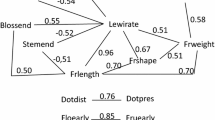Summary
The C-banded karyotypes of six Allium cepa cultivars, including five dry onions and one shallot, were investigated. Chromosome length and banding patterns were statistically analysed. The value of C-banding for distinguishing these Allium cepa cultivars was tested by the application of a discriminant analysis. It appeared that chromosomal differences between cultivars exist, but are too small to be clearly demonstrated with moderate efforts. Large variation within plants and between plants within cultivars, presumably for the greater part caused by the applied method, obscured the variation between the cultivars.
Similar content being viewed by others
References
Anonymous, 1984. 33e Beschrijvende Rassenlijst. Commissie voor de Samenstelling van de Rassenlijst voor Groentegewassen, Wageningen. pp. 182–187.
Astley, D., N.L.Innes & Q.P.van derMeer, 1982. Genetic resources of Allium species. IBPGR Secretariat, Rome: 38 pp.
Blackith, R.E. & R.A. Reyment, 1971. Multivariate morphometrics. London.
Cortes, F., G.Gonzalez-Gill & J.F.Lopez-Saez, 1981. Differential staining of late replicating DNA-rich regions in Allium cepa chromosomes. Caryologia 33: 193–202.
Dixon, W.J., 1985. (Ed.). BMDP Statistical Software Manual 1985. University of California Press, Berkeley, Los Angeles, London.
Dunn, C.G. & B.S., Everitt, 1982. An introduction to mathematical taxonomy. Cambridge University Press, Cambridge.
ElGadi, A. & T.T.Elkington, 1975. Comparison of the Giemsa C-band karyotypes of Allium cepa, A. fistulosum and A. galanthum. Chromosoma 51: 19–23.
Federov, A.A. (Ed.), 1969. Chromosome numbers of flowering plants. Reprint by O. Koeltz Science Publishers Koenigstein/West Germany, pp. 376–378.
Fiskesjö, G., 1974. Two types of constitutive heterochromatin made visible in Allium by a rapid C-banding method. Hereditas 78: 153–156.
Fiskejö, G. 1975. Chromosomal relationships between three species of Allium as revealed by C-banding. Heriditas 81: 23–32.
Friebe, B., 1976. Differential Giemsa staining of heterochromatic regions in the chromosomes of Vicia faba, Allium cepa and Paeonia tenuifolia. Theor. Appl. Genet. 47: 275–283.
Greilhuber, J., 1973. Differential staining of plant chromosomes after hydrochloric acid treatments (Hy-bands). Öst. Bot. Z. 122: 333–351.
ICNCP, 1980. International Code of Nomenclature for Cultivated Plants. C.D.Brickell (Ed.). Bohn, Scheltema & Holkema, Utrecht. W. Junk BV Publ. The Hague. Regnum Vegetabile, volume 104.
Jones, R.N., 1983. Cytogenetic Evolution in the genus Allium. Cytogenetics of Crop Plants. M.S. Swaminathan, P.K. Gupta & U. Sinha (Eds.) MacMillan India Limited: 516–555.
Joshi, C.P. & P.K.Ranjekar, 1980. Technique for heterochromatin visualization and chromosome banding in plants. Nucleus 23: 169–176.
Kalkman, E.R., 1984. Analysis of the C-banded karyotype of Allium cepa L. Standard system of nomenclature and polymorphism. Genetica 65: 141–148.
Legendre, L. & P.Legendre, 1983. Numerical Ecology. Elsevier Scientific Publishing Company. Amsterdam, Oxford, New York.
Lighty, R.W. & R.L.Plaisted, 1960. The evaluation of the sources of variation in the preparation of a karyotype of a clone. Cytologia 25: 1–7.
Sato, S., 1981. Cytological studies on the satellited chromosomes of Allium cepa. Caryologia 34: 431–440.
Schweizer, D. & F.Ehrendorfer, 1976. Giemsa banded karyo-types, systematics and evolution in Anacyclus (Asteraceae-Anthemideae). Plant Syst. Evol. 126: 107–148.
Stack, S.M. & C.R.Clarke 1973. Differential Giemsa staining of the telomeres of Allium cepa chromosomes: observations related to chromosome pairing. Can. J. Genet. Cytol. 15: 619–624.
Stack, S.M. & D.E.Commings, 1979. The chromosomes and DNA of Allium cepa. Chromosoma 70: 161–181.
Stearn, W.T., 1960. Allium and Milula in the central and eastern Himalaya. Bull. Brit. Mus. (Nat. Hist.), Bot. Ser. 2: 161–191.
Tanasch, L., 1984. Cytologisch-züchterische Untersuchungen an Knoblauch (Allium sativum L.). Aus dem Institut für Pflanzenbau und Pflanzenzüchtung: 109–125.
Vosa, C.G., 1976. Heterochromatic patterns in Allium. Heredity 36: 383–392.
Author information
Authors and Affiliations
Rights and permissions
About this article
Cite this article
de Putter, M., Van de Vooren, J.G. Identification of Allium cepa L. cultivars by means of statistical analysis of C-banded chromosomes. Euphytica 39, 153–160 (1988). https://doi.org/10.1007/BF00039868
Received:
Accepted:
Issue Date:
DOI: https://doi.org/10.1007/BF00039868




